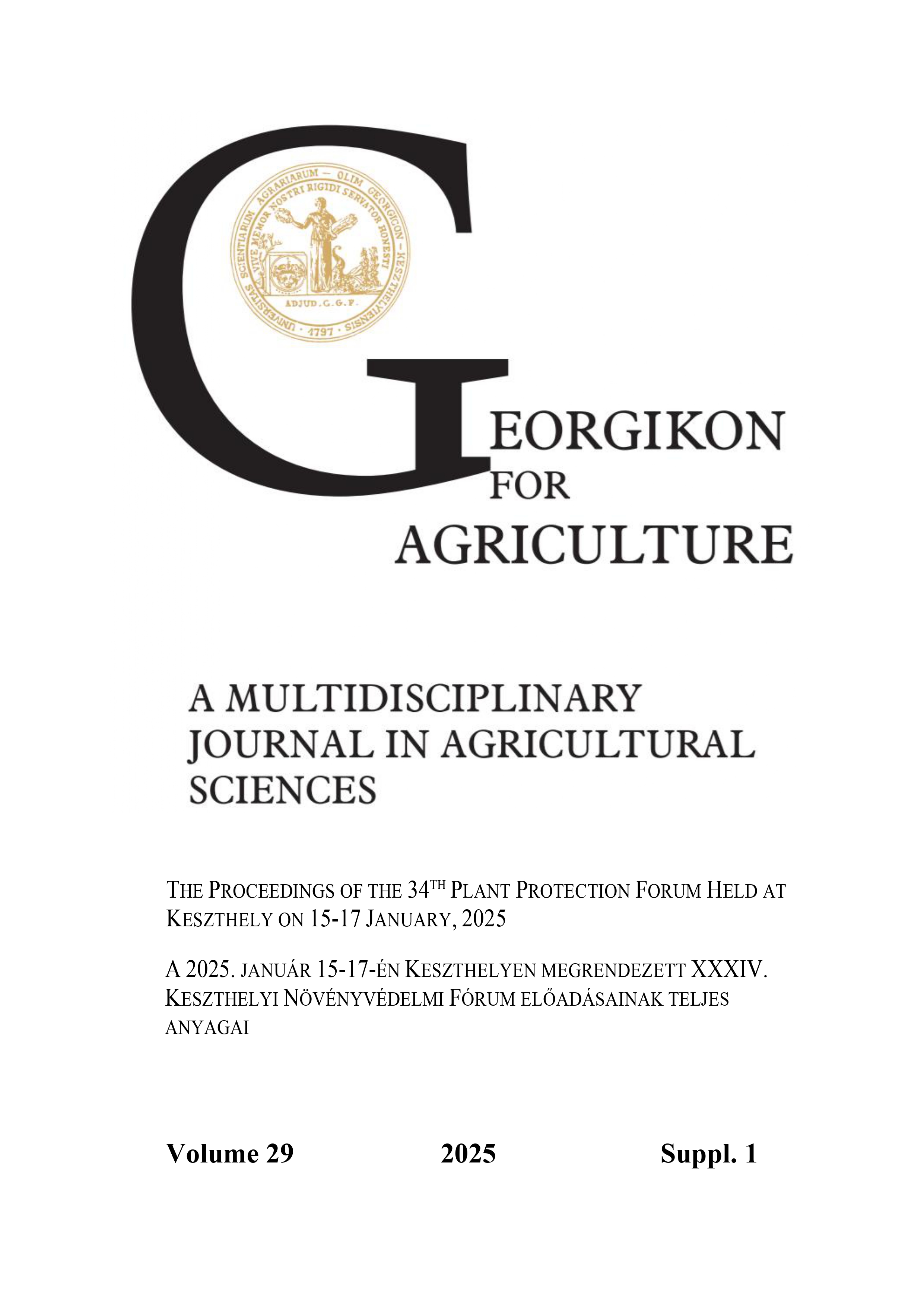A termőhely földrajzi paramétereinek meghatározó szerepe szántóföldi növényfajok aszályindexének alakulásában Magyarországon
DOI:
https://doi.org/10.70809/6565Kulcsszavak:
szántóföldi növények, földrajzi paraméterek, termőhely, aszály, érzékenységAbsztrakt
A szántóföldi növények növekedésében és fejlődésében döntő szerepe van a termőhely vízellátottságának. A MATE növénytermesztési kutatásaiban vizsgálták a termesztett növényfajok és a termőhely földrajzi paraméterei által meghatározott ariditási értékek összefüggését. Hat növényfaj (cukorrépa Beta vulgaris, őszi árpa Hordeum vulgare, őszi búza Triticum aestivum, kukorica Zea mays, burgonya Solanum tuberosum, és lucerna Medicago sativa) termesztési paramétereit elemezték tizenkét termőhely (Békéscsaba, Budapest, Debrecen, Miskolc, Mosonmagyaróvár, Nagykanizsa, Nyíregyháza, Pécs, Siófok, Szeged, Szolnok, Szombathely) meteorológiai állomásainak adatbázisán. A vizsgálat során az aszályindexek (PAI), illetve a sérülékenységi indexek (VI) kölcsönhatásait tanulmányozták. A kapott eredmények alapján igazolható volt, hogy a kalászos gabonák aszálytűró képessége volt a legnagyobb, a kukoricáé és a burgonyáé pedig a legkisebb. A lucerna és a cukorrépa vízellátottsági kitettsége is jelentős volt. A termőhely földrajzi paraméterei közül a tengerszint feletti magasság az aszályindexekkel negatív korrelációt mutatott.
Hivatkozások
Bihari, Z. (ed). 2012. Délkelet-Európai Transznacionális Együttműködési Program. (South-East Europen Transnational Cooperation Programme). Országos Meteorológiai Szolgálat. Budapest. https://www.met.hu/doc/DMCSEE/DMCSEE_zaro_kiadvany.pdf
FAO 2021. The State of the World’s Land and Water Resources for Food and Agriculture – Systems at breaking point (SOLAW 2021) Synthesis report 2021. https://doi.org/10.4060/cb7654en
Jolánkai, M., Gyuricza, Cs., Tarnawa, Á., Pósa, B., Birkás, M. 2012. A drought assessment survey of Hungarian soils. Proceedings. 47th Croatian – 7th International Symposium on Agriculture. Ed.: M. Pospišil. Opatija. 492–496 pp.
KSH 2022. Főbb növényi kultúrák terméseredményei. Crop yield of main field crops in Hungary. https://www.ksh.hu/docs/hun/xftp/stattukor/fobbnoveny/2020/index.html
Lakatos, M., Szalai, S. 2010. Aszályindex-számítás és –térképzés Magyarországra a DMCSEE keretében, Drought indexing and mapping in Hungary by DMCSEE. Agrofórum. 21 (8) 49–51.
OMSZ 2022. Average annual precipitation and annual mean temperature. https://www.met.hu/eghajlat/magyarorszag_eghajlata/altalanos_eghajlati_ jellemzes/csapadek/
Pálfai, I., 1990. Description and forecasting of droughts in Hungary. Proc. of 14th Congress on Irrigation and Drainage (ICID), Rio de Janeiro, 1990, Vol. 1-C, 151–158.
Tarnawa, Á., Gyuricza, Cs., Máté, A., Sallai, A., Pósa, B., Jolánkai M. 2012. A drought assessment survey based on the evapotranspiration balance of major field crops in Hungary. In: Transport of water, chemicals and energy in the soil-plant-atmosphere system. Ed.: A. Celková. UH SAV. Bratislava. 786–791.
Tarnawa, Á., Klupács, H., Sallai, A., Szalay, K., Kassai, M.K., Nyárai, H.F., Jolánkai, M. 2010. Study on the impact of main climatic factors of crop production in a mathematical model. In: Transport of water, chemicals and energy in the soil-plant-atmosphere system. Ed: A. Celková. Institute of Hydrology, Bratislava, 566–571.
UNEP 1992. World Atlas of Desertification. A global overview on geography. https://wedocs.unep.org/handle/20.500.11822/42137
Várallyay, G. 2006. Soil degradation processes and extreme soil moisture regime as environmental problems in the Carpathian Basin. Agrokémia és Talajtan. 55 (1–2) 9–18. https://doi.org/10.1556/agrokem.55.2006.1.2
Vermes L. (ed.) 2011. Aszálystratégia (Drought strategy). Manuscript VM, Budapest.
Letöltések
Megjelent
Folyóirat szám
Rovat
License
Copyright (c) 2025 M. Kassai Katalin, Kende Zoltán, Tarnawa Ákos, Jolánkai Márton

This work is licensed under a Creative Commons Attribution-NonCommercial-NoDerivatives 4.0 International License.
The articel is under the Creative Commons 4.0 standard licenc: CC-BY-NC-ND-4.0. Under the following terms: You must give appropriate credit, provide a link to the license, and indicate if changes were made. You may do so in any reasonable manner, but not in any way that suggests the licensor endorses you or your use. You may not use the material for commercial purposes. If you remix, transform, or build upon the material, you may not distribute the modified material. You may not apply legal terms or technological measures that legally restrict others from doing anything the license permits.




 Georgikon for Agriculture
Georgikon for Agriculture